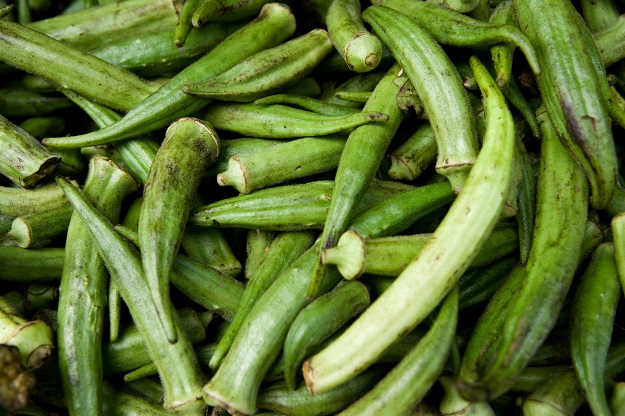Okra is a quintessential summer crop in the South. Also known by its Swahili name, gumbo, okra is not native to the United States; it originates from northeast Africa, from where it spread to the Mediterranean and eventually to Brazil and the Americas.

Okra really multi-tasks in the garden. Related to hibiscus and hollyhock, most varieties of okra grow rather tall and feature colorful flowers. Okra does cross-pollinate, so seed savers should take that into consideration and plant only one variety, or separate different varieties by a great deal of distance. Not only are okra pods tasty and attractive, but many gardeners use the plant to control Japanese beetles, which are attracted to the yellow flowers. The beetles chew on the leaves of the plants, which are poisonous to them, leading to their demise. Okra seeds have also been roasted, ground, and used as a coffee substitute.
The plants are prolific producers, so four to six okra plants are normally enough to keep the average family well supplied throughout the season. This depends on the family, however, and their taste for okra. More plants can be planted, of course, for those who intend to freeze or can garden fresh okra. It is best to start more seeds than plants, and then thin weaker plants, as okra plants can be rather sensitive about transplanting.
Okra plants require warmth to successfully produce pods. Gardeners in cooler climates report success in container growing okra, using black pots or black plastic to retain heat around the base of the plant. Some creative gardeners devise racks to allow okra plants to mingle outdoors during daylight hours and roll them inside the greenhouse to protect from cold nighttime temperatures. In warmer climates, okra can be directly planted in the garden 3 to 4 weeks after the last frost; nighttime temperatures should average over 50 degrees Fahrenheit.
The number of varieties of okra rivals the number of cooking methods. Clemson Spineless is an old variety; it was an All-American winner in 1939 and is still extremely popular today. There are red types, including Burgundy, which grows to 4-5 ft tall, with red pods, stems and leaf ribs. The pods return to the usual green color upon cooking. Annie Oakley is a petite okra variety, suited to containers. Lee Okra is another small plant for limited spaces, topping out at 2-3 feet in height.
Regardless of the variety you choose, keep an eye out for pests, including some types of cabbage worms and aphids. Harvest the pods when they are 2-3 inches long; okra is not a vegetable that improves in taste or texture with size. Cut the pods from the plants regularly, leaving just a little bit of stem and the cap intact. It’s advisable to wear gloves when harvesting or handling okra pods as they are covered with tiny hairy spines which can cause skin irritation.
Okra is commonly pickled or otherwise canned, but the pods also freeze well. Pods should be clean and relatively blemish-free. Boil the pods quickly and then stop the cooking by plunging them into ice water. Drain pods, then freeze, either individually or in bags. This method helps the okra retain its color and texture and it will be a happy addition to a midwinter soup or gumbo.
Speaking of gumbo, the Louisiana style stew is a preparation that takes full advantage of the mucilaginous property of gumbo. A layman might be tempted to call okra slimy, but this is what gives the stew its silky thickness. The mucilage is more noticeable the more okra is cut, so those who dislike the slippery texture may prefer okra pods whole. Small pods are delicious when sautéed whole in butter until dark roasted spots and lines appear. A sprinkle of Cajun seasoning or Louisiana-style hot sauce compliments the flavor of the okra massively.
Another common preparation for okra is frying. The mucilage allows a cornmeal breading to stick fairly well to the okra slices, but they can be egg battered if necessary. Toss with cornmeal to coat and then fry in hot oil until the breading is golden. This really needs no seasoning other than a shake of salt, but children and southerners are known for dipping fried okra in a buttermilk ranch dressing or white gravy.
International preparations take the familiar flavor of okra to another level. Try okra curries, sautés, and stews, each with the characteristic flavors of their counties of origin. Okra’s buttery and nutty flavor is complimented by several spices.
Simplicity is elegance in this favorite preparation – our family first came across roasted okra as an appetizer at a wedding. Amounts are not set in stone, as it’s rather easy for okra lovers to eat a lot of okra. Simply clean and stem “enough” okra, leaving the cap intact. Blot the pods dry and place them in a large bowl, turning to coat with olive oil. At this point, the okra can be spread on a pan and roasted at 400 degrees until tender, with roasted spots. Alternatively, the okra can be threaded crosswise onto two parallel skewers and grilled until tender. Either way, a grind of sea salt is most welcome.
Amy Ambrosius is a writer and budding gardener living deep in the heart of Texas with her family. She owes her interest in writing, food, and gardening to family; having learned to cook and appreciate poetry under the tutelage of her great-grandmother.
Related Articles & Free Email Newsletter
How to Grow and Prepare Lima Beans
The Best Vegetables to Grow in a Greenhouse




Comment here